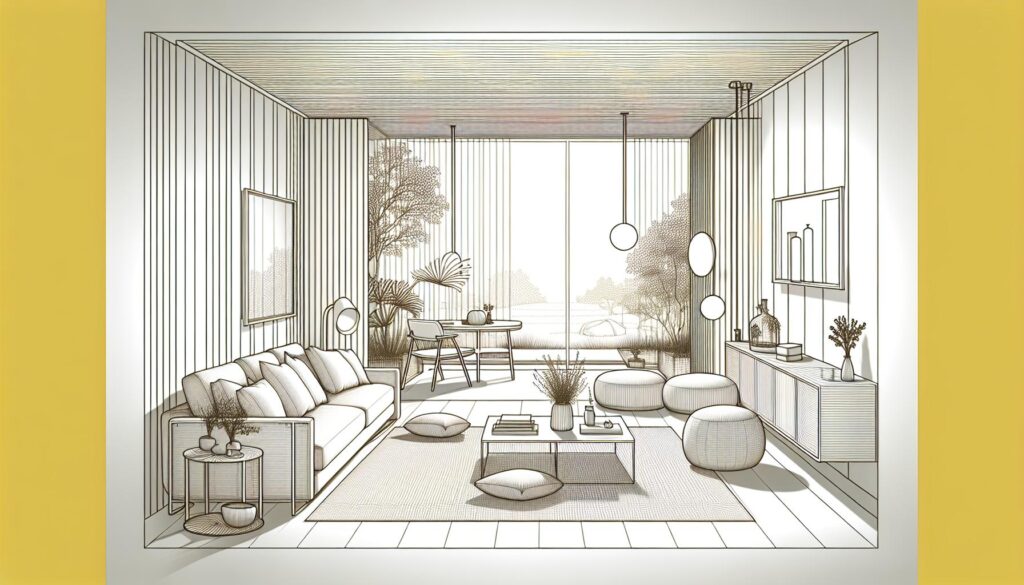Embracing minimalism in your living space can bring a sense of calm and tranquility to your daily life. I’ve always been fascinated by the idea of creating a serene environment through simplicity and intentional design choices.
In this article, I’ll share practical tips and insights on how to cultivate a minimalist living space that promotes mindfulness and clarity. From decluttering techniques to minimalist decor ideas, I’ll guide you through the process of creating a harmonious and Zen-inspired home.
Understanding Minimalism in Living Spaces
Minimalism in living spaces is not just about decluttering and simplifying; it’s a lifestyle choice that can profoundly impact your well-being. Embracing minimalism means focusing on what truly matters and eliminating distractions that can overwhelm the senses. It’s about creating a space that promotes calmness and clarity, allowing you to feel more relaxed and at peace in your own home.
By adopting a minimalist approach to your living space, you can reduce stress levels and increase productivity. A clutter-free environment helps to clear the mind and fosters a sense of mental clarity. With fewer distractions around, you can focus better on the tasks at hand and improve your overall well-being.
Minimalist living spaces are designed to be functional and purposeful. Every object in the space serves a specific role, and unnecessary items are removed to make room for what truly adds value to your life. This intentional design philosophy not only enhances the aesthetic appeal of your home but also simplifies your daily routines.
When you understand the essence of minimalism in living spaces, you start to appreciate the beauty of simplicity and elegance. It’s about creating a sanctuary that reflects your values and nurtures your soul. By curating a space that is free from excess and clutter, you can experience a sense of freedom and serenity every time you walk through your door.
Benefits of Minimalist Living
Embracing minimalist living spaces promotes clarity and calmness by reducing visual clutter.
Minimalism enhances mental clarity and focus, boosting productivity in daily tasks.
A minimalist approach to design creates functional spaces that align with individual needs and values.
Minimalist living helps reduce stress levels and fosters a sense of peace and serenity at home.
| Statistics | Data |
|---|---|
| Global stress levels | 75% of adults report experiencing moderate to high levels of stress regularly. |
| Productivity boost | 91% of employees feel they are more productive in a clean and organized workspace. |
Minimalist living allows for a more sustainable lifestyle, focusing on quality over quantity.
Creating a minimalist environment eliminates distractions and encourages a mindful and intentional way of living.
In minimalist spaces, there is more room for creativity and self-expression, leading to a deeper connection with one’s surroundings.
The simplicity of minimalist design promotes relaxation and a sense of well-being, offering a sanctuary from the busyness of everyday life.
Decluttering Techniques for a Zen Home
When creating a Zen living space, decluttering is essential. Here are some techniques I recommend to achieve a minimalist and peaceful environment:
- Start by sorting your belongings into categories like keep, donate, or recycle to make the process more manageable.
- Minimize duplicates by keeping only what you need or truly love.
- Organize items in a way that is visually appealing and functional, using storage solutions like bins or baskets to maintain order.
- Digitize documents and photos to reduce paper clutter and create a more streamlined space.
- Limit decorations and ornaments to a few meaningful pieces that bring you joy.
- Implement a regular decluttering routine to prevent items from accumulating over time.
By following these decluttering techniques, you can create a Zen home that promotes a sense of calm and tranquility.
Minimalist Decor Ideas for a Calm Environment
When it comes to creating a Zen living space, less is more. Here are some minimalist decor ideas to help achieve a calm and serene environment:
- Neutral Color Palette: Opt for soft hues like whites, creams, and light grays to create a sense of tranquility in the space.
- Natural Elements: Incorporate natural materials such as wood, bamboo, and stone to bring a touch of the outdoors inside.
- Decluttered Surfaces: Keep surfaces clear of unnecessary items to promote a sense of openness and clarity in the room.
- Functional Furniture: Choose multi-purpose furniture that serves a practical function while maintaining a clean and uncluttered look.
- Artful Displays: Display a few meaningful art pieces or photographs to add a personal touch to the space without overwhelming it.
- Plants: Introduce greenery with low-maintenance plants to bring life and freshness into the room.
- Natural Lighting: Maximize natural light sources and opt for airy curtains to create a bright and inviting atmosphere.
Incorporating these minimalist decor ideas can help create a harmonious and tranquil living space that promotes relaxation and peace.
Cultivating Mindfulness and Clarity Through Design
In creating a minimalist living space, I focus on cultivating mindfulness and clarity through intentional design choices. By eliminating clutter and simplifying the environment, I allow room for a clear mind and a sense of tranquility to flourish.
Here are some key strategies I incorporate to enhance mindfulness and clarity in my living space:
- Decluttering: Removing unnecessary items creates a sense of openness and calm in the space.
- Intentional Placement: Thoughtfully arranging furniture and decor items promotes flow and harmony.
- Natural Elements: Incorporating wood, stone, and plants connects me with nature and promotes a sense of grounding.
- Purposeful Lighting: Utilizing natural light and soft lighting enhances the ambiance and fosters a peaceful atmosphere.
- Personal Reflection Areas: Designating a space for meditation or reflection encourages moments of introspection and mindfulness.
By consciously designing my living space to prioritize simplicity and functionality, I cultivate an environment that supports my well-being and promotes a sense of peace and clarity in my daily life.
Key Takeaways
- Embracing minimalism in living spaces promotes clarity and calmness by reducing visual clutter.
- Minimalist environments enhance mental clarity and focus, ultimately boosting productivity in daily tasks.
- Creating a minimalist living space allows for a more sustainable lifestyle, focusing on quality over quantity.
- Minimalist design promotes relaxation and well-being, offering a sanctuary from daily busyness.
- Decluttering techniques, such as sorting belongings and minimizing duplicates, are essential for achieving a Zen home.
- Minimalist decor ideas like neutral color palettes, natural elements, and decluttered surfaces help create a calm and serene living space.
Conclusion
Creating a minimalist living space isn’t just about aesthetics; it’s a way to foster mindfulness and tranquility in our daily lives. By embracing intentional design choices like decluttering, strategic furniture placement, natural elements, purposeful lighting, and personal reflection areas, we can cultivate a sense of peace and clarity within our homes. Prioritizing simplicity and functionality in our living spaces not only enhances our well-being but also encourages a deeper connection with ourselves and our surroundings. Embracing the Zen of minimalist living spaces is a powerful way to create a harmonious environment that supports our mental and emotional health.



